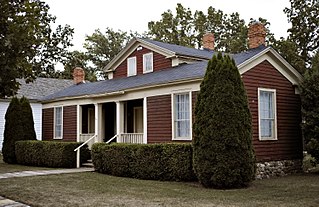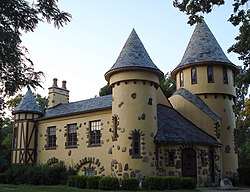
Owosso is the largest city in Shiawassee County in the U.S. state of Michigan. The population was 15,194 at the 2010 census. The city is mostly surrounded by Owosso Township on its west, but the two are administered autonomously. The city was named after Chief Wosso, an Ojibwe leader of the Shiawassee area.

James Oliver Curwood was an American action-adventure writer and conservationist. His books were often based on adventures set in the Hudson Bay area, the Yukon or Alaska and ranked among the top-ten best sellers in the United States in the early and mid 1920s, according to Publishers Weekly. At least one hundred and eighty motion pictures have been based on or directly inspired by his novels and short stories; one was produced in three versions from 1919 to 1953. At the time of his death, Curwood was the highest paid author in the world.

Bewabic State Park is a public recreation area covering 315 acres (127 ha) on the shore of Fortune Lake, four miles (6.4 km) west of Crystal Falls in Iron County, Michigan. The state park's rich Civilian Conservation Corps history is evidenced by the CCC structures still in use. The park was listed on the National Register of Historic Places for its CCC-related architecture in 2016.

Castle Farms is a special events facility located in Charlevoix, Michigan. It was constructed in 1918 by Albert Loeb, who was the Vice President of Sears, Roebuck and Company, and it was designed by Arthur Heun.
Church of St. Dismas, the Good Thief is a historic Roman Catholic church at the Clinton Correctional Facility on Cook Street in Dannemora, New York.
The Curwood Festival is a celebration of the American novelist James Oliver Curwood in Owosso, Michigan. Many of his novels were written in Curwood Castle on the banks of the Shiawassee River.

The Colin McCormick House is a historical house in Owosso, Michigan, designed by Edger Ingersoll, and is notable for its size. It has had only 4 owners in its more than 120-year history. The last member of the McCormick family died in the house at 107 years of age. Edger Ingersoll incorporated features like the slate roof, crocheted roof ridging, hipped roof, scalloped trim, and more. It lies at 220 E. Exchange. The house was added to the National Register of Historic Places in 1980.

The T. Pierson Farm is a historic farm located at Hockessin, New Castle County, Delaware. The property includes three contributing buildings. They are a stone house with late-19th century frame addition, a stone and frame bank barn, and a mid-19th century frame outbuilding. The house is a two-story, two-bay, gable-roofed building that is constructed with rubble fieldstone. It has a two-story, three-bay, frame wing to form a five-bay main facade. The barn features a pyramidal-roofed cupola with louvered sides atop the gable roof.

William Morgan Farm is a historic farm located near Newark, New Castle County, Delaware. The property includes two contributing buildings. They are a stone bank barn (1809) and a stone dwelling (1813). The barn is constructed of uncoursed, rubble fieldstone and is cornered with large fieldstone quoins. The house is a two-story, three bay, gable-roofed fieldstone building with an original two-story, gable-roofed rear ell.

The Giles Gilbert House is a private house located at 306 N. Camburn Street in Stanton, Michigan. It was designated a Michigan State Historic Site in 1984 and listed on the National Register of Historic Places in 1987.

St Patrick's Cathedral is a heritage-listed Roman Catholic cathedral on James Street, South Toowoomba, Toowoomba, Toowoomba Region, Queensland, Australia. It was designed by Toowoomba architect James Marks and was built from 1883 to 1935. The site of the cathedral was originally a church and school known as St Patrick's Church School. In 1899, the school was moved to make way for the building of the cathedral and in 1959 renamed as St Saviour's School. St Patrick's Cathedral was added to the Queensland Heritage Register on 21 October 1992.

The Hartness House is a historic house at 30 Orchard Street in Springfield, Vermont. Built in 1904, it is one Vermont's relatively small number of high-style Shingle style houses. It was built for James Hartness, owner of a local machine factory and later Governor of Vermont. The house, now a small hotel, was listed on the National Register of Historic Places in 1978.

The Ebenezer Gould House is a historic house in the Corunna Historical Village in Corunna, Michigan. The house was built in 1840 and added to the National Register of Historic Places on November 4, 1980.

The Floyd R. Mechem House is a single-family home located at 1402 Hill Street in Ann Arbor, Michigan. It was listed on the National Register of Historic Places in 1999.

The Langford and Lydia McMichael Sutherland Farmstead is a farm located at 797 Textile Road in Pittsfield Charter Township, Michigan. It was listed on the National Register of Historic Places in 2006. It is now the Sutherland-Wilson Farm Historic Site.

The George Louk Farm is a rural farmstead located at 1885 Tooley Road near Howell, Michigan. It was listed on the National Register of Historic Places in 1995.

The John N. Ingersoll House is a single-family home located at 570 West Corunna Avenue in Corunna, Michigan. It was listed on the National Register of Historic Places in 1980.

The Elias Comstock Cabin is a single-family home located at the corner of Curwood Castle Drive and John Street in Owosso, Michigan. It was listed on the National Register of Historic Places in 1980. It is the oldest residence still extant in the City of Owosso.

The Oliver Street Historic District is a primarily residential historic district, located along Oliver Street between Third and Oak Street, as well as some adjacent sections of Williams and Goodhue Streets, in Owosso, Michigan. It was listed on the National Register of Historic Places in 1980.





















